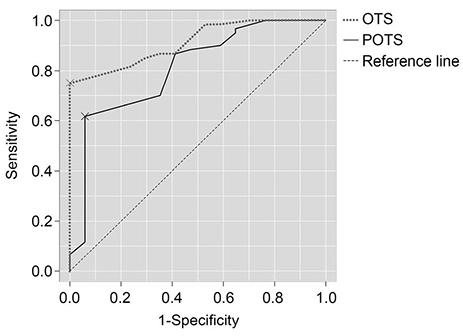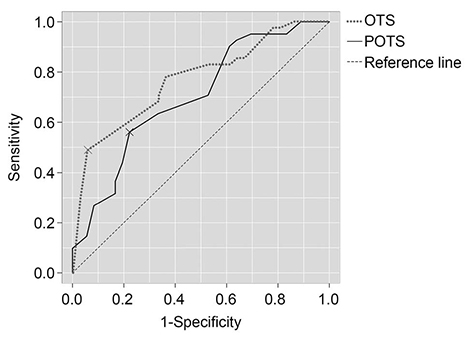J Korean Ophthalmol Soc.
2018 Nov;59(11):1062-1070. 10.3341/jkos.2018.59.11.1062.
The Relationship between Visual Outcome and Ocular Trauma Score after Open Globe Injuries in Children
- Affiliations
-
- 1Department of Ophthalmology, School of Medicine, Kyungpook National University, Daegu, Korea. supersbj@daum.net
- 2Department of Ophthalmology, Kyungpook National University Hospital, Daegu, Korea.
- KMID: 2426368
- DOI: http://doi.org/10.3341/jkos.2018.59.11.1062
Abstract
- PURPOSE
We evaluated the prognostic factors of open globe injuries in children and adolescents, and compared the ocular trauma score (OTS) and pediatric penetrating ocular trauma score (POTS).
METHODS
We performed a retrospective review of 77 children under 18 years of age who visited our clinic with open globe injuries between May 1993 and April 2014. We investigated the factors that may affect final visual acuity. We also compared the OTS and POTS using receiver operating characteristic curves as a method to predict final visual acuity.
RESULTS
By univariate analysis, an initial visual acuity less than 20/200, globe rupture, wound size greater than 7.0 mm, retinal detachment, lens dislocation, and total number of operations contributed to worse visual outcomes (<20/200). Conversely, central corneal involvement, traumatic cataract, wound size less than 7.0 mm, and initial visual acuity greater than 20/200 were better prognostic indicators (≥20/32). Both OTS and POTS had diagnostic value as a predictor of final visual acuity, although there were no statistically significant differences between the two scoring systems.
CONCLUSIONS
Initial visual acuity and wound size are important prognostic factors for the final visual acuity in children and adolescent, following open globe injuries. Both OTS and POTS are reliable prognostic models for open globe injuries in children and adolescents.
MeSH Terms
Figure
Reference
-
1. Kuhn F, Morris R, Witherspoon CD. Birmingham eye trauma terminology (BETT): terminology and classification of mechanical eye injuries. Ophthalmol Clin North Am. 2002; 15:139, v–143, v.
Article2. Schmidt GW, Broman AT, Hindman HB, Grant MP. Vision survival after open globe injury predicted by classification and regression tree analysis. Ophthalmology. 2008; 115:202–209.
Article3. Négrel AD, Thylefors B. The global impact of eye injuries. Ophthalmic Epidemiol. 1998; 5:143–169.
Article4. Thompson CG, Kumar N, Billson FA, Martin F. The aetiology of perforating ocular injuries in children. Br J Ophthalmol. 2002; 86:920–922.
Article5. Esmaeli B, Elner SG, Schork MA, Elner VM. Visual outcome and ocular survival after penetrating trauma. A clinicopathologic study. Ophthalmology. 1995; 102:393–400.6. Sternberg P Jr, de Juan E Jr, Michels RG, Auer C. Multivariate analysis of prognostic factors in penetrating ocular injuries. Am J Ophthalmol. 1984; 98:467–472.
Article7. De Juan E Jr, Sternberg P Jr, Michels RG. Penetrating ocular injuries. types of injuries and visual results. Ophthalmology. 1983; 90:1318–1322.8. Rahman I, Maino A, Devadason D, Leatherbarrow B. Open globe injuries: factors predictive of poor outcome. . Eye (Lond). 2006; 20:1336–1341.
Article9. Dalma-Weiszhausz J, Quiroz-Mercado H, Morales-Cantón V, et al. Vitrectomy for ocular trauma: a question of timing. Eur J Ophthalmol. 1996; 6:460–463.
Article10. Miyake Y, Ando F. Surgical results of vitrectomy in ocular trauma. Retina. 1983; 3:265–268.
Article11. Pieramici DJ, MacCumber MW, Humayun MU, et al. Open-globe injury. update on types of injuries and visual results. Ophthalmology. 1996; 103:1798–1803.12. Hutton WL, Fuller DG. Factors influencing final visual results in severely injured eyes. Am J Ophthalmol. 1984; 97:715–722.
Article13. Punnonen E, Laatikainen L. Prognosis of perforating eye injuries with intraocular foreign bodies. Acta Ophthalmol (Copenh). 1989; 67:483–491.
Article14. Matthews GP, Das A, Brown S. Visual outcome and ocular survival in patients with retinal detachments secondary to openor closed-globe injuries. Ophthalmic Surg Lasers. 1998; 29:48–54.
Article15. Brinton GS, Aaberg TM, Reeser FH, et al. Surgical results in ocular trauma involving the posterior segment. Am J Ophthalmol. 1982; 93:271–278.
Article16. Martin DF, Meredith TA, Topping TM, et al. Perforating (through-and-through) injuries of the globe. surgical results with vitrectomy. Arch Ophthalmol. 1991; 109:951–956.17. Sternberg P Jr, de Juan E Jr, Michels RG. Penetrating ocular injuries in young patients. initial injuries and visual results. Retina. 1984; 4:5–8.18. Barr CC. Prognostic factors in corneoscleral lacerations. Arch Ophthalmol. 1983; 101:919–924.
Article19. Groessl S, Nanda SK, Mieler WF. Assault-related penetrating ocular injury. Am J Ophthalmol. 1993; 116:26–33.
Article20. Unal MH, Aydin A, Sonmez M, et al. Validation of the ocular trauma score for intraocular foreign bodies in deadly weapon-related open-globe injuries. Ophthalmic Surg Lasers Imaging. 2008; 39:121–124.
Article21. Acar U, Tok OY, Acar DE, et al. A new ocular trauma score in pediatric penetrating eye injuries. Eye (Lond). 2011; 25:370–374.
Article22. Zhu L, Wu Z, Feng J, et al. Two kinds of ocular trauma score for paediatric traumatic cataract in penetrating eye injuries. Injury. 2015; 46:1828–1833.
Article23. Choovuthayakorn J, Patikulsila P, Patikulsila D, et al. Characteristics and outcomes of pediatric open globe injury. Int ophthalmol. 2014; 34:839–844.
Article24. Schörkhuber MM, Wackernagel W, Riedl R, et al. Ocular trauma scores in pediatric open globe injuries. Br J ophthalmol. 2014; 98:664–668.25. Kuhn F, Maisiak R, Mann L, et al. The Ocular Trauma Score (OTS). Ophthalmol Clin North Am. 2002; 15:163–165. vi
Article26. Sobaci G, Akin T, Erdem U, et al. Ocular trauma score in deadly weapon-related open-globe injuries. Am J Ophthalmol. 2006; 141:760–761.27. Dosková H. Evaluation of results of the penetrating injuries with intraocular foreign body with the Ocular Trauma Score (OTS). Cesk Slov Oftalmol. 2006; 62:48–52.28. Unver YB, Kapran Z, Acar N, Altan T. Ocular trauma score in open-globe injuries. J Trauma. 2009; 66:1030–1032.
Article29. Uysal Y, Mutlu FM, Sobaci G. Ocular trauma score in childhood open-globe injuries. J Trauma. 2008; 65:1284–1286.
Article30. Han SB, Yu HG. Visual outcome after open globe injury and its predictive factors in Korea. J Trauma. 2010; 69:E66–E72.
Article31. Lee YH, Kwag JY, Lee SB. The predictability of ocular trauma score and prognostic factors of open globe injury. J Korean Ophthalmol Soc. 2012; 53:825–832.
Article32. Shin YI, Lee YH, Kim KN, Lee SB. The availability of modified ocular trauma score in Korean patients with open globe injury. J Korean Ophthalmol Soc. 2013; 54:1902–1906.
Article33. Yoo JH, Lee H, Lee J, et al. A statistical observation of ocular injuries and visual predictive value of ocular trauma score. J Korean Ophthalmol Soc. 2011; 52:1024–1029.
Article34. Choi JS, Kim SS, Yi KP. A clinical study of pediatric ocular injuries through emergency room. J Korean Ophthalmol Soc. 1990; 31:69–79.35. Kim HJ, Kwon JY. A clinical observation of perforating ocular injuries. J Korean Ophthalmol Soc. 1989; 30:123–130.36. Oh TS, Ahn Y. Clinical picture of the pediatric ocular trauma. J Korean Ophthalmol Soc. 2001; 42:119–126.37. Seo KS. Development of Korean preventive guideline for eye injury. Cheongju: KCDC;2010. 02. p. 160. Report No.: KCDC 2010-E33005-00.38. Kim CR, Lee CS, Kim JB, Park YG. Clinical evaluation of the pediatric ocular trauma. J Korean ophthalmol Soc. 2000; 41:993–999.39. Jandeck C, Kellner U, Bornfeld N, Foerster MH. Open globe injuries in children. Graefe's Arch Clin Exp Ophthalmol. 2000; 238:420–426.
Article40. Kim JH, Yu YS. Clinical course and predictive factors of final visual acuity in children with penetrating ocular trauma. J Korean ophthalmol Soc. 2003; 44:699–705.41. Read SP, Canuoto KM. Traumatic open globe injury in young pediatric patients: characterization of a novel prognostic score. J AAPOS. 2016; 20:141–144.
Article
- Full Text Links
- Actions
-
Cited
- CITED
-
- Close
- Share
- Similar articles
-
- The Predictability of Ocular Trauma Score and Prognostic Factors of Open Globe Injury
- Predictive values of the Pediatric Penetrating Ocular Trauma Score and the Toddler/Infant Ocular Trauma Score in Brazilian children with open globe injury
- Changes in the Clinical Manifestations of Ocular Injuries Induced by Power Lawn Mowers
- The Availability of Modified Ocular Trauma Score in Korean Patients with Open Globe Injury
- Characteristics and Prognostic Factors of Open-Globe Injuries in Korea



